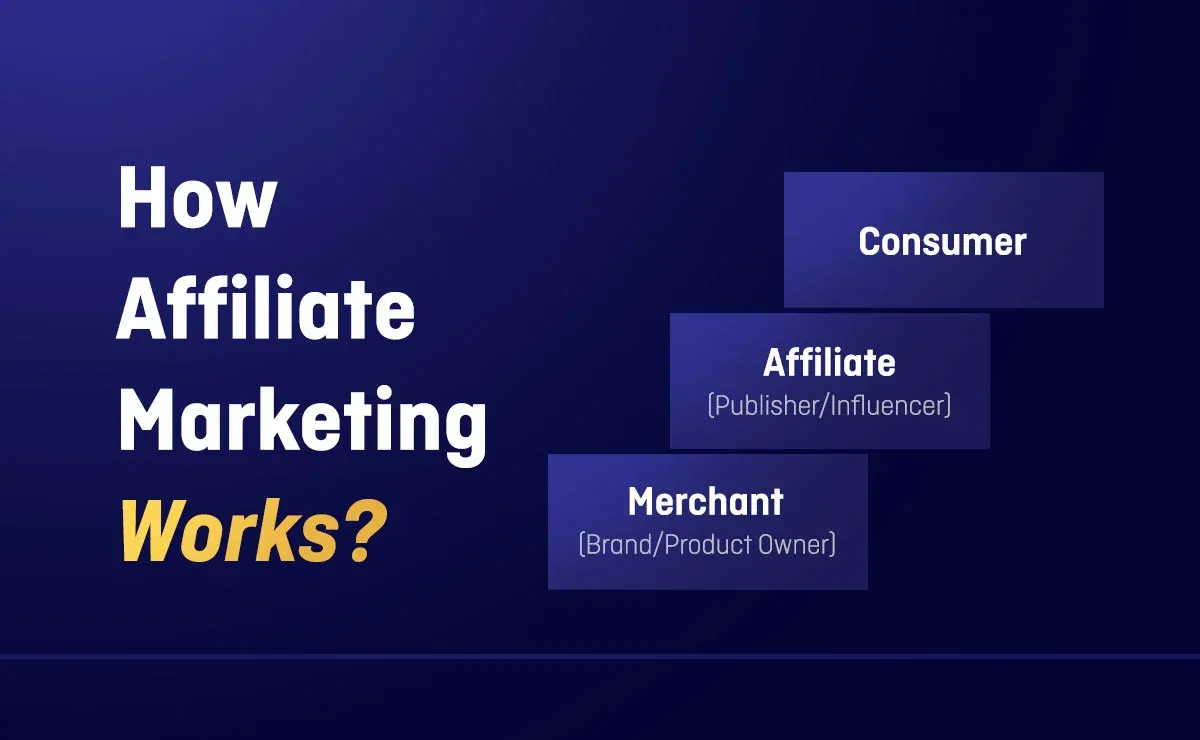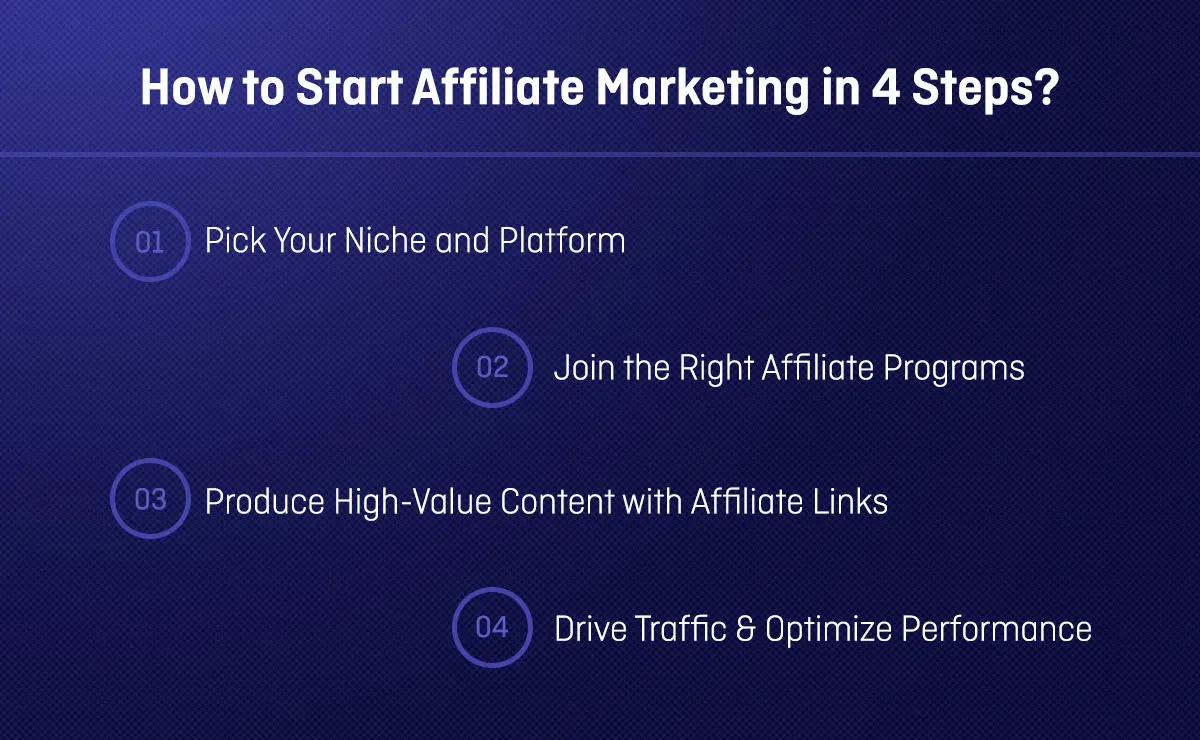What is Affiliate Marketing?

Amidst businesses facing rising costs and limited returns from traditional paid advertising, the emergent success of grassroots content creators leveraging product recommendations highlights a pivotal shift in digital commerce, underscoring the growing relevance of affiliate marketing.
It involves partnering with creators like bloggers, influencers, and niche websites who recommend your products to their audiences. Instead of paying for ads upfront, you pay these "affiliates" a commission only when their recommendations lead to actual sales or desired actions.
This article will break down how affiliate marketing works, why it's becoming essential in online sales, and the different ways it can be implemented.
What Is Affiliate Marketing?
Affiliate marketing is a results-driven promotional strategy where companies collaborate with independent publishers, called affiliates, to boost visitor engagement or revenue. In essence, affiliates earn commissions by promoting a merchant’s products or services via unique referral links, and they receive payment only when a predefined action (such as a sale, lead, or click) is completed. This model benefits all parties involved:
- Merchants (sellers or product creators) extend their reach with minimal upfront cost.
- Affiliates monetize their platforms or audiences without generating their products.
- Consumers discover products through trustworthy recommendations.
Globally, affiliate marketing is on a significant growth trajectory. Industry analysts project that the affiliate marketing sector will expand at an 18.86% CAGR from 2023 to 2032, achieving a market size of approximately $40 billion by 2032.
For management students, affiliate marketing offers a practical lens into performance-driven partnerships, cost-effective customer acquisition, and the intricacies of digital sales channels. Understanding its underlying mechanisms and strategic implications is crucial in an era where businesses increasingly prioritize measurable ROI and scalable marketing models.
How Affiliate Marketing Works?

Affiliate marketing turns individual recommendations into measurable sales by linking three core players through a tracking system and performance-based payouts:
Merchant (Brand/Product Owner)
A company or individual with a product or service to sell. The merchant develops an affiliate program either in-house or through an affiliate network to recruit affiliates and define commission structures, cookie windows, and payout terms.
Affiliate (Publisher/Influencer)
An individual or organization that promotes the merchant’s offerings using digital content, paid advertising, social media, email marketing, or other channels. Affiliates embed special tracking links or codes in their content, like blog posts, YouTube videos, Instagram stories, WhatsApp broadcasts, etc. They also disclose their affiliation clearly.
Consumer
The end user who clicks on an affiliate link or uses the code to visit the merchant site completes the desired action, like making a purchase. A small “cookie” is stored in their browser, tagging the affiliate ID for the duration of the cookie window.
Tracking & Attribution
Whenever a user clicks on an affiliate link, a browser-stored text file, known as a cookie, is generated on their device. This cookie records the affiliate ID and tracks the user’s activity for a specified window. When a customer finalizes the desired transaction within the designated period, the conversion is credited to the affiliate, resulting in a paid incentive.
Payment
Once the affiliate earnings meet the program’s minimum threshold (often ₹1,000–₹5,000), payments are disbursed monthly or bi-monthly via bank transfer or digital wallet.
By paying only for genuine results (sales, leads, or installs), affiliate marketing minimizes wasted spend for brands and creates an opportunity for affiliates to earn passive income through content they already produce.
Social Commerce and Affiliate Marketing
With social media’s evolution toward integrated shopping experiences, social commerce has emerged as a powerful extension of affiliate marketing. Here’s why it’s so important:
- Seamless, In-App Buying Experience: By enabling users to browse and purchase products without leaving their favorite apps, social commerce removes friction from the buying journey. Affiliates see higher click-through and conversion rates because consumers can act on impulse, while brands enjoy reduced cart abandonment and a smoother path to sale.
- Access to Massive, Engaged Audiences: With over 5.24 billion people on social media, platforms like Facebook, Instagram, TikTok, and Pinterest offer unprecedented reach. Affiliates who integrate shoppable posts or live-stream demos tap into these built-in audiences; brands can extend their visibility organically through influencers and user shares, amplifying word-of-mouth.
- Rich Data and Targeting Capabilities: Social networks provide granular analytics—demographics, click behavior, and engagement metrics—that affiliates and brands can use to refine campaigns. Polls, stories, and embedded forms let you gather direct feedback, segment audiences, and deliver personalized offers that boost relevance and ROI.
- Community-Driven Commerce: Social platforms are inherently social: likes, comments, shares, and direct messages foster two-way conversations. Affiliates build trust and loyalty by engaging followers in real time, while brands strengthen their community around products. This sense of belonging not only drives repeat purchases but also generates authentic user-generated content and recommendations.
- Lucrative Growth Opportunities: Affiliates who master in-app selling and brands that optimize their social storefronts both stand to capture a significant share of this expanding market, all while leveraging existing content and relationships rather than investing in costly, stand-alone e-commerce sites.
In short, social commerce aligns perfectly with affiliate marketing’s performance-based model: it delivers measurable outcomes, capitalizes on engaged communities, and leverages the social context to drive both immediate and sustained revenue growth.
Types of Affiliate Marketing
Affiliate partnerships vary by the depth of the affiliate’s connection to the product and audience. Pat Flynn’s framework breaks them into three categories:
Unattached Affiliate Marketing
Unattached affiliate marketing is the most transactional of the three. Here, affiliates have no personal stake in the product and no prior relationship with the audience they target. Their role is purely that of a middleman: they buy traffic through channels like PPC or display ads, drop an affiliate link into the ad copy, and hope that enough clicks turn into purchases.
Because there’s no trust or authority built with potential buyers, unattached affiliates must rely heavily on ad spend and optimization tactics to drive conversions.
Related Affiliate Marketing
Affiliates in this category have an established platform like a blog, podcast, or social media following within a particular niche, but they haven’t personally used the products they promote. Their authority stems from their specialized knowledge and the confidence they’ve built with their followers.
They position affiliate offers alongside their regular content, often in sidebars, newsletters, or within posts, and benefit from a degree of audience goodwill. However, this model carries reputational risk if a promoted product fails to meet expectations, since the affiliate’s endorsement implies relevance but not necessarily firsthand experience.
Involved Affiliate Marketing
Involved affiliate marketing is the most authentic and relationship-driven approach, built on trust and personal experience. Affiliates who genuinely use and benefit from the products they promote integrate them naturally into their content, offering honest reviews, tutorials, or testimonials.
Because their recommendations stem from real conviction, they earn higher engagement, stronger conversions, and lasting audience loyalty. While this method requires more effort through product testing, detailed content creation, and transparency, it fosters deeper, more sustainable partnerships between affiliates and merchants, making it the most effective and relationship-driven strategy.
Pros and Cons of Affiliate Marketing
Like any strategic tool, affiliate marketing brings both advantages and challenges.
Pros
- Performance-Based Budgeting: Companies pay only for actual results like sales, leads, or clicks, minimizing wasted spending.
- Scalable Outreach: Affiliates operate independently, extending the brand’s footprint without adding internal headcount.
- Diverse Channels: From blogs to live streams, affiliate marketing adapts to any content format.
- Passive Income Streams: Quality content with embedded links continues earning long after publication.
Cons
- Commission Volatility: Affiliates depend on merchant policies, and sudden changes in commission rates or cookie settings can disrupt earnings.
- Trust Management: Poor-quality products or undisclosed relationships can damage affiliate and merchant reputations.
- Attribution Complexities: Cookie blocking, ad blockers, and multi-device journeys may obscure true conversion sources.
- Competitive Pressure: Popular niches become saturated, increasing the cost and effort required to stand out.
For brands, evaluating these trade-offs is critical for advising on resource allocation, risk management, and partnership governance.
Who Should Become an Affiliate Marketer?
Affiliate marketing is uniquely suited to anyone who already produces content, cultivates an audience, or has a deep passion for a particular subject and who’s eager to transform that engagement into a revenue stream without the overhead of creating their own products. If you:
- Run a blog, podcast, or YouTube channel, and you can seamlessly weave product recommendations into your existing content and earn commissions when your followers act on your advice.
- Manage an email newsletter or social media community, and you can deliver targeted offers directly into inboxes or feeds, leveraging the trust you’ve built to drive clicks and conversions.
- Excel at SEO or paid advertising, and you can capture high-intent search traffic or strategically target ads around niche keywords, turning clicks into affiliate sales without holding inventory.
- Are an industry expert or enthusiast, you can review tools, services, or products within your specialty—whether it’s fitness gear, productivity software, or financial services—and provide the kind of in-depth insights that audiences value.
- Love data and optimization, and you’ll thrive on tracking performance metrics (click-through rates, conversion rates, AOV) and refining your campaigns to maximize ROI.
Success in affiliate marketing doesn’t require millions of followers. The key factors include credibility, alignment with a specific niche, and the capacity to provide real, meaningful benefits. If you’re ready to leverage your expertise, creativity, and audience rapport into a performance-based income model, affiliate marketing could be the perfect fit.
How Do Affiliate Marketers Make Money?
Affiliate marketers earn income by acting as performance-based partners for brands and merchants. Rather than charging upfront fees, they receive a commission whenever their promotional efforts drive a predefined action—most commonly a sale, but sometimes a qualified lead, a click, or even a software installation.
At its simplest, an affiliate embeds a unique tracking link or code into their content—whether that’s a blog post, YouTube video description, social media story, or email newsletter. When a reader clicks that link and completes the desired action on the merchant’s site, the affiliate network or merchant platform records the source of the referral (via browser cookies) and credits the affiliate with the corresponding payout.
Most affiliates join established networks such as Amazon Associates, ShareASale, or CJ Affiliate which handle link tracking, reporting, and payout processing on their behalf. By aligning compensation with real results, affiliate marketing transforms promotional content into an ongoing revenue stream: once quality content is live, it can continue to generate commissions passively, day after day.
How to Start Affiliate Marketing in 4 Steps?

Pick Your Niche and Platform
- Choose a subject you’re deeply interested in and that also has substantial commercial interest.
- Choose the content channel that best suits your strengths and audience: a blog or website for SEO-driven traffic, a YouTube channel for video tutorials, social media profiles for short-form posts, or an email newsletter for direct outreach.
Join the Right Affiliate Programs
- Research affiliate networks and direct programs offered by brands in your niche.
- Compare commission rates, cookie durations (tracking windows), and payment thresholds.
- Sign up for multiple programs to diversify your offerings but focus on products you believe in and that match your audience’s needs.
Produce High-Value Content with Affiliate Links
- Create informative, engaging content that addresses your audience’s questions or problems.
- Integrate affiliate links naturally within your content, and include a clear disclosure (e.g., “I may earn a commission if you buy through these links”) to comply with regulations and maintain trust.
- Use on-page elements like call-to-action buttons, comparison tables, or product boxes to highlight your top recommendations.
Drive Traffic and Optimize Performance
- Promote your content through SEO (targeting relevant keywords), social media (organic posts and paid ads), and email campaigns.
- Monitor key metrics—click-through rates, conversion rates, average order value—and identify which pieces of content or channels drive the most revenue.
- Continuously A/B test headlines, calls to action, and link placements; refresh or repurpose high-performing content; and, as you grow, negotiate higher commission tiers with your top partners.
Affiliate Marketing Trends for 2025
Here are some of the recent trends of affiliate marketing:
- AI-Powered Optimization: Predictive analytics will refine audience targeting, budget allocation, and content personalization.AI-powered chatbots and personalized suggestion systems will create more interactive, sales-optimized user interactions.
- Deepening Performance-Based Models: Brands will sharpen commission structures—tiered incentives, bonuses for high-value conversions, and hybrid pay-per-action schemes—to align affiliate rewards more closely with real revenue outcomes.
- Cross-Brand Collaborations: Non-competing companies with overlapping audiences will launch co-branded affiliate campaigns, leveraging shared newsletters, social contests, and on-site features to tap into each other’s customer base.
- Results-Oriented Influencer Partnerships: Marketers will demand transparent tracking from influencers, moving beyond vanity metrics (likes, views) to focus exclusively on affiliate-attributed sales and leads.
- Metaverse and Virtual Commerce: Early adopters will experiment with affiliate programs inside virtual environments—selling both digital goods (NFTs, wearables) and real-world products via immersive storefronts in metaverse platforms.
Summing Up
Affiliate marketing represents a symbiotic alliance where brands access new audiences through motivated partners who, in turn, monetize their content or influence. For management students, it offers a live case study of performance-based incentives, digital ecosystems, and data-driven decision-making.
By mastering the mechanics, understanding varied affiliate models, and keeping pace with emerging trends, you’ll be well-equipped to integrate affiliate strategies into future marketing plans or to launch your own successful affiliate venture. Remember: in affiliate marketing, authenticity, strategic alignment, and continuous optimization are your greatest assets.





